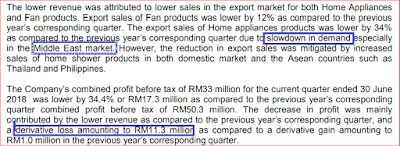What are 'Basis Point (BPS)'
Basis point (BPS) refers to a common unit of measure for
interest rates and other percentages in finance. One basis point is equal to
1/100th of 1%, or 0.01%, or 0.0001, and is used to denote the percentage change
in a financial instrument. The relationship between percentage changes and
basis points can be summarized as follows: 1% change = 100 basis points, and
0.01% = 1 basis point.
Bps commonly used in interest measurement and Forex term,
hardly in stock. think in bond investment it is more frequently use as interest
is the only measurement of earning.
example as below,
100 Bps = 1% ; 1Bps = 0.01%
this should be simple to remember and understand.
BREAKING DOWN 'Basis Point (BPS)'
The "basis" in basis point comes from the base
move between two percentages, or the spread between two interest rates. Because
the changes recorded are usually narrow, and because small changes can have
outsized outcomes, the "basis" is a fraction of a percent.
Example,
The basis point is commonly used for calculating changes in
interest rates, equity indices, and the yield of a fixed-income security(Bond). It is common for bonds and loans to be
quoted in basis point terms. For example, it could be said that the interest
rate offered by your bank is 50 basis points higher than LIBOR (London
Interbank Offered Rate). A bond whose yield increases from 5% to 5.5% is said
to increase by 50 basis points; or interest rates that have risen 1% are said
to have increased by 100 basis points. If the Federal Reserve Board raises the
target interest rate by 25 basis points, it means that rates have risen by
0.25% percentage points. If rates were at 2.50%, and the Fed raised them by
0.25%, or 25 basis points, the new interest rate would be 2.75%.
Reason of used of Basis point,
By using basis points in conversation, traders and analysts
remove some of the ambiguity that can arise when talking about things in
percentage moves. For example, if a financial instrument is priced at a 10%
rate of interest and the rate experiences a 10% increase, it could conceivably
mean that it is now 0.10 x (1 + 0.10) = 11% OR it could also mean 10% + 10% =
20%. The intent of the statement is unclear. Use of basis points in this case
makes the meaning obvious: if the instrument is priced at a 10% rate of
interest and experiences a 100 bp move up, it is now 11%. The 20% result would
occur if there was instead a move of 1,000 bps.
The Price Value of a Basis Point (PVBP) is a measure of the
absolute value of the change in price of a bond for a one basis point change in
yield. It is another way to measure interest-rate risk, similar to duration
which measures the percent change in a bond price given a 1% change in rates.
PVBP is just a special case of dollar duration. Instead of
using a 100 basis point change, the price value of a basis point simply uses a
1 basis point change. It does not matter if there is an increase or decrease in
rates, because such a small move in rates will be about the same in either
direction. This may also be referred to as DV01, or the dollar value change for
a 1 bp move.
Basis points are also used when referring to the cost of
mutual funds and exchange-traded funds (ETFs). A mutual fund that has an annual
management expense ratio (MER) of 0.15% will be quoted as having 15 bps. When
funds are compared, basis points is used to provide a clearer understanding of
the difference between the cost of investment funds. For example, an analyst
may state that a fund with 0.35% in expenses is 10 basis points lower than
another with an annual expense of 0.45%.
details can refer below,
Read more: Basis Point (BPS) | Investopedia
https://www.investopedia.com/terms/b/basispoint.asp#ixzz5KoXLe2wk
Follow us: Investopedia on Facebook










































